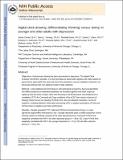Digital Clock Drawing: Differentiating “Thinking” versus “Doing” in Younger and Older Adults with Depression
Author(s)
Cohen, Jamie; Penney, Dana L.; Davis, Randall; Libon, David J.; Swenson, Rodney A.; Ajilore, Olusola; Kumar, Anand; Lamar, Melissa; ... Show more Show less
DownloadDavis_Digital clock.pdf (372.8Kb)
OPEN_ACCESS_POLICY
Open Access Policy
Creative Commons Attribution-Noncommercial-Share Alike
Terms of use
Metadata
Show full item recordAbstract
Psychomotor slowing has been documented in depression. The digital Clock Drawing Test (dCDT) provides: (i) a novel technique to assess both cognitive and motor aspects of psychomotor speed within the same task and (ii) the potential to uncover subtleties of behavior not previously detected with non-digitized modes of data collection. Using digitized pen technology in 106 participants grouped by Age (younger/older) and Affect (euthymic/unmedicated depressed), we recorded cognitive and motor output by capturing how the clock is drawn rather than focusing on the final product. We divided time to completion (TTC) for Command and Copy conditions of the dCDT into metrics of percent of drawing (%Ink) versus non-drawing (%Think) time. We also obtained composite Z-scores of cognition, including attention/information processing (AIP), to explore associations of %Ink and %Think times to cognitive and motor performance. Despite equivalent TTC, %Ink and %Think Command times (Copy n.s.) were significant (AgeXAffect interaction: p=.03)—younger depressed spent a smaller proportion of time drawing relative to thinking compared to the older depressed group. Command %Think time negatively correlated with AIP in the older depressed group (r=−.46; p=.02). Copy %Think time negatively correlated with AIP in the younger depressed (r=−.47; p=.03) and older euthymic groups (r=−.51; p=.01). The dCDT differentiated aspects of psychomotor slowing in depression regardless of age, while dCDT/cognitive associates for younger adults with depression mimicked patterns of older euthymics.
Date issued
2014-09Department
Massachusetts Institute of Technology. Computer Science and Artificial Intelligence Laboratory; Massachusetts Institute of Technology. Department of Electrical Engineering and Computer ScienceJournal
Journal of the International Neuropsychological Society
Publisher
Cambridge University Press
Citation
Cohen, Jamie, Dana L. Penney, Randall Davis, David J. Libon, Rodney A. Swenson, Olusola Ajilore, Anand Kumar, and Melissa Lamar. “Digital Clock Drawing: Differentiating ‘Thinking’ versus ‘Doing’ in Younger and Older Adults with Depression.” Journal of the International Neuropsychological Society 20, no. 09 (October 2014): 920–28.
Version: Author's final manuscript
ISSN
1355-6177
1469-7661